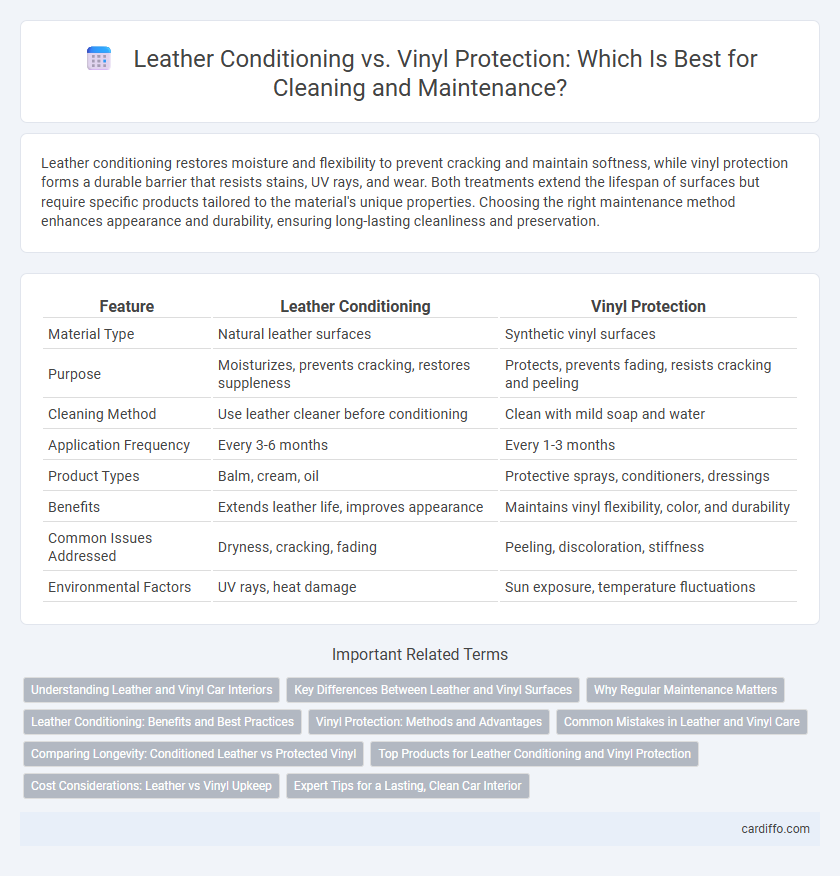Leather conditioning restores moisture and flexibility to prevent cracking and maintain softness, while vinyl protection forms a durable barrier that resists stains, UV rays, and wear. Both treatments extend the lifespan of surfaces but require specific products tailored to the material's unique properties. Choosing the right maintenance method enhances appearance and durability, ensuring long-lasting cleanliness and preservation.
Table of Comparison
| Feature | Leather Conditioning | Vinyl Protection |
|---|---|---|
| Material Type | Natural leather surfaces | Synthetic vinyl surfaces |
| Purpose | Moisturizes, prevents cracking, restores suppleness | Protects, prevents fading, resists cracking and peeling |
| Cleaning Method | Use leather cleaner before conditioning | Clean with mild soap and water |
| Application Frequency | Every 3-6 months | Every 1-3 months |
| Product Types | Balm, cream, oil | Protective sprays, conditioners, dressings |
| Benefits | Extends leather life, improves appearance | Maintains vinyl flexibility, color, and durability |
| Common Issues Addressed | Dryness, cracking, fading | Peeling, discoloration, stiffness |
| Environmental Factors | UV rays, heat damage | Sun exposure, temperature fluctuations |
Understanding Leather and Vinyl Car Interiors
Leather conditioning nourishes natural pores with oils and moisturizers to maintain suppleness and prevent cracking, while vinyl protection seals synthetic surfaces against UV rays and surface abrasion. Understanding leather requires recognizing its organic fibers needing hydration and breathability, whereas vinyl involves a plastic-based material demanding a protective barrier. Proper care enhances longevity, maintains aesthetic appeal, and preserves the texture unique to each interior type.
Key Differences Between Leather and Vinyl Surfaces
Leather surfaces require conditioning to maintain their natural oils, prevent cracking, and preserve suppleness, whereas vinyl protection focuses on creating a durable barrier to resist UV damage and prevent peeling. Leather absorbs conditioners that nourish the material, while vinyl benefits more from protective coatings that shield against moisture and fading. Understanding these key differences ensures proper maintenance tailored specifically to the unique properties of leather and vinyl surfaces.
Why Regular Maintenance Matters
Regular maintenance preserves the integrity and appearance of leather by preventing cracks, dryness, and fading through effective conditioning treatments. For vinyl surfaces, consistent protection wards off brittleness, discoloration, and surface degradation caused by UV exposure and everyday wear. Implementing routine care tailored to each material extends lifespan, maintains flexibility, and ensures optimal aesthetic appeal in automotive and furniture applications.
Leather Conditioning: Benefits and Best Practices
Leather conditioning restores natural oils, enhancing flexibility and preventing cracks, which extends leather's lifespan significantly. Use a pH-balanced, leather-specific conditioner applied with a soft cloth to avoid damage and promote deep absorption. Regular conditioning every 3 to 6 months maintains softness, prevents fading, and protects against environmental wear, making it essential for high-quality leather care.
Vinyl Protection: Methods and Advantages
Vinyl protection involves applying specialized sealants or protectants that form a durable barrier against UV rays, dirt, and moisture, extending the life of the material. Methods include the use of silicone-based sprays, polyurethane coatings, and regular cleaning with mild soap solutions to maintain flexibility and prevent cracking. Vinyl protection enhances resistance to fading and cracking, making it essential for automotive interiors, furniture, and outdoor vinyl products.
Common Mistakes in Leather and Vinyl Care
Common mistakes in leather and vinyl care include using harsh cleaners that strip natural oils from leather, causing cracking and fading, or applying vinyl protectants meant for leather, which can lead to surface dullness and reduced flexibility. Over-wetting both materials often results in water damage, while neglecting regular conditioning on leather accelerates wear and reduces durability. Proper product selection based on material-specific formulations preserves texture, color, and longevity in both leather conditioning and vinyl protection routines.
Comparing Longevity: Conditioned Leather vs Protected Vinyl
Conditioned leather typically lasts 5 to 10 years with proper care, maintaining its suppleness and resisting cracks. Protected vinyl surfaces, treated with specialized protectants, can endure 3 to 7 years while preventing fading and surface cracking. The longevity of conditioned leather generally surpasses protected vinyl due to its natural durability and ability to be rejuvenated over time.
Top Products for Leather Conditioning and Vinyl Protection
Top products for leather conditioning include Leather Honey, Lexol Leather Conditioner, and Chamberlain's Leather Milk, each formulated to nourish and protect leather surfaces from drying and cracking. For vinyl protection, Meguiar's M38 Vinyl Protectant, 303 Aerospace Protectant, and Mothers VLR Vinyl, Leather, Rubber Care help maintain flexibility while shielding surfaces from UV damage and fading. Choosing the right product depends on the material type and desired level of protection to ensure longevity and appearance retention.
Cost Considerations: Leather vs Vinyl Upkeep
Leather conditioning typically demands higher initial investment due to premium conditioners and professional treatments, but it extends the lifespan of leather surfaces significantly. Vinyl protection often involves more affordable products and simpler maintenance routines, though frequent reapplications may increase long-term costs. Balancing upfront expenses with ongoing upkeep is crucial when choosing between leather and vinyl materials for effective cleaning and protection.
Expert Tips for a Lasting, Clean Car Interior
Leather conditioning preserves natural oils and prevents cracking by using specialized creams rich in lanolin and beeswax, maintaining a soft and supple surface. Vinyl protection involves applying UV-resistant sprays or conditioners that create a barrier against fading, cracking, and discoloration caused by sun exposure. Experts recommend regular maintenance schedules tailored to each material's properties to extend the life and appearance of your car interior effectively.
Leather conditioning vs Vinyl protection Infographic

 cardiffo.com
cardiffo.com